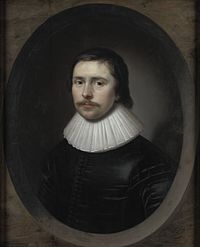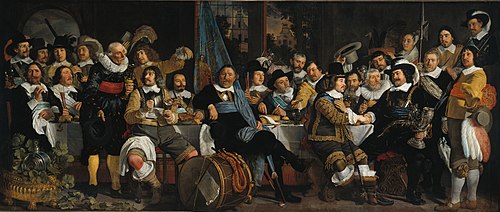Talk:1600–1650 in Western fashion/Archive 1
| This is an archive of past discussions. Do not edit the contents of this page. If you wish to start a new discussion or revive an old one, please do so on the current talk page. |
| Archive 1 |
Images
Are these pages too heavy? If the images are smaller, the captions become a problem. Thoughts? PKM 20:15, 8 January 2006 (UTC)
Coming soon
- Men's clothes
- Puritan influence
PKM 20:15, 8 January 2006 (UTC)
- Did men's fashion and added galleries. I am extraordinarily pleased to have stumbled across the back view of 1630s clothes. Still researching Puritan clothes. PKM 19:33, 15 January 2006 (UTC)
Puritan influence
I have followed this article from the Cavaliers page. Not my expertise and a very interesting read. During this period in English history, fashion said more about an English gentleman's political stance than at any other time in history. I think the page needs to mention that:
- This is high fashion for the gentle classes, not everyone was wearing this sort of thing as no one could go down to the market and buy a cheap imported rip-offs.
- There should be much more prominence given to the puritan side (Roundheads), as in the long term this has had a much greater influence on male clothing fashions than the courtly male fashions of that the age.
--PBS 11:56, 25 February 2006 (UTC)
| This article was recategorized in 2006 in accordance with a scheme for organizing articles in Category:History of clothing. That effort has been superseded by WikiProject Fashion. |
- - PKM 03:30, 23 June 2006 (UTC)
October 2006 edits
I have made a series of edits to expand this section. Now that I have a copy of Emilie Gordenker's 2001 Van Dyck and the Representation of Dress in Seventeenth-Century Portraiture to work with, I have made some edits to reflect material in that book.
We need information of Louis XIV's edicts about dress that banned ruffs, paned sleeves, and so on at Court (for all? for most, by rank?). I have tantalizing clues but no actual documentation. Anyone?
And I have inadvertantly ambiguated shoes by replicating material under that heading as well as under men's and women's dress; I see it now but I can't fix it right this minute. More anon. - PKM 20:30, 29 October 2006 (UTC)
- Fixed the duplicate info on shoes. - PKM 19:57, 17 December 2006 (UTC)
Louis XIII?
<<In 1633, Louis XIV of France issued an edict requiring simplified dress at the French court; ruffs, paned sleeves, and ribbons were outlawed in favor of plain linen collars and cuffs.>>
I am not a fashion buff, but I do know that Louis XIV was not born until 1638. Perhaps you meant his father, Louis XIII? This does seem to be in keeping with his austere style . . .
Cheers, Jessicamoved the following commnet, I am sure it should have been in this section
- Re Louis, there is a before and after engraving by Abraham Bosse, with I think a good pic at the BnF or Commons. Before is laid out on a chair. Johnbod 19:11, 16 September 2007 (UTC)
- Here [Image:Abrahambosse edict 1633.jpg] - Commons quality not great. Johnbod 19:13, 16 September 2007 (UTC)
- The Bosse is in there; I uploaded it some while ago. :-)
- But we do need to discuss the Edict of 1633 more thoroughly as we expand. - PKM 19:43, 16 September 2007 (UTC)
- Sorry, saw that later. Is there anything other than the caption on it now? I'm not sure if it had a lasting effect. Need to find out more. Johnbod 22:06, 16 September 2007 (UTC)
Royal Courts and simplicity



There have been a few edits (this has gone back-and-forth) that separate the entire Women's and Men's section under a heading of "Fashions influenced by Royal Courts" and contrasting that with "Simplicity of dress". A reading of the text will show that simplicty of dress was dictated by royal courts in this period; the contrast is meaningless.
I have some sympathy with the idea of improving our coverage of everyday clothing, but in fact "fashion" did begin with the upper classes.
I propose to put the structure back as it was and in harmony with the other articles in this series (Women's and Men's sections as Level 2 heads, and simplicity of dress back up with the Overview where I think it belongs as a long-term trend that began in this period.
Thoughts? - PKM (talk) 17:44, 18 February 2008 (UTC)
- I am against it, there was a civil war in England during this period and the political/religious factions dressed differently. Just look at the dress difference between Charles I and the the Oliver Cromwell who became Lord Protector. --PBS (talk) 19:24, 2 May 2008 (UTC)
- You have to be very careful in this area - in fact Van Dyck's best aristocratic clients tended to be Parliamentarians, and the middle classes dressed much the same whichever side they took, as the article explains. As well as class, age was a factor as well. It is easier to see what is going on in Calvinist-dominated Dutch portraiture of the period, especially as unlike England, they have genre paintings where the middle classes are not dressed up in their best black suits. I would restore it as before. The article covers the whole of Europe, and not just England. Johnbod (talk) 03:30, 3 May 2008 (UTC)
- Do you think that during the Protectorate that the men who were in power such as James Berry (Major-General) dressed in high court fashion? Or were they likely to be a "plain, russet-coated Captain, that knows what he fights for, and loves what he knows, than that you call a Gentleman and is nothing else."(See Wikiquote:Oliver Cromwell). These are the people who banned frivolity like Christmas, so it is unlikely that they had much time for courtly fashion. If one looks at wood cuttings of the House of Commons during this period (1600-1650) one see plenty of men dressed in plain cloths. For example see images of John Pym who was a representative of a sizeable faction within the country.
- If you look at images of Thomas Fairfax and George Goring the division in their dress is easy to see and even without knowing it one could guess which side they fough. Now it may be that away from the portrait studio they all dressed in identical fashion, but cloths were clearly used -- as they have always been -- to present a persona to the audience who were to view the portrait in a certain light, and there is enough evidence in portraits of the period to show that there was a difference in the dress style depending on political allegiance.
- It is documented that when the charge of treason in the name of "the good People of England" was read out at the start of the trial of Charles I that Lady who cried out it "was a lye, not half, nor a quarter of the people of England" agreed, and that the well dressed woman was suspected of being Anne Fairfax, Fairfax's wife (a woman who had already stated that her husband "hath more wit than to be here"), so I am not arguing that (as in Northern Ireland where football shirts can be used to identify ones religion) that dress could be used to identify political allegiance, just that there were two influences, so to argue that there was one dress fashion is misleading and it is better to divided the article into two sections. --PBS (talk) 11:58, 3 May 2008 (UTC)
- Firstly I would repeat that this is an article on Western fashion 1600-1650, not English clothing during the Civil War. Like most of the series it already, rather inevitably, gives too much coverage to English and French styles, and very little to those of Germany, Spain Scandinavia and Central Europe.
- It is in fact extremely difficult when looking at English portraits of the period to tell from clothes alone which side was taken in the Civil War. Aristocrats look like aristocrats -look at the strongly puritan Robert Rich, 2nd Earl of Warwick), or Algernon Percy, 10th Earl of Northumberland - MPs like MPs, generals like generals, and rank and file like rank and file. Try a trip round the room in the National Portrait Gallery dividing up those shown on dress alone. The differences between classes and age groups are much greater than between political sides, and those latter are, as with all tribal fashion differences, greatly played up in comments by the two groups. Look at the Somerset House Conference from the beginning of the period, not to mention The Surrender of Breda and the many Dutch group paintings from the period. Obviously the New Model Army in particular changed the social composition of the officer corps, bringing in more "plain, russet-coated Captain"s from lower down the middle classes. We probably could do with more images of sober business suits, but this does not justify rearranging the layout of the article. The article covers farly well the status of black at the time, but does not I think cover the way in which contemporaries were intensely aware of differences between cloth, which is of course hard to convey in paintings - let alone woodcuts, which have tended to show everyone dressed very simply since the 15th century, due to the relative crudity of the medium, and in England the fairly low degree of skill of the blockcutters compared to the Continent. On PKM's point above, if anything I would say simplicity of dress began in, and was more strongly marked as a religious-based contrast in, the latter 16th century than this period. Johnbod (talk) 13:23, 3 May 2008 (UTC)
Suggested image
Not really my subject area, thought I'd post this here and see if another editor might evaluate it for inclusion. Currently a Featured Picture candidate. Cheers, mikaultalk 13:54, 25 January 2009 (UTC)

